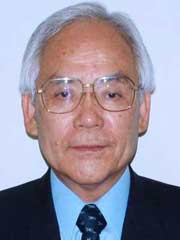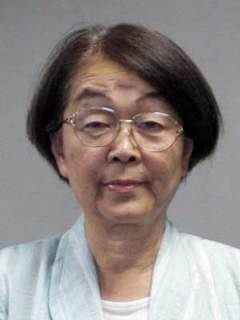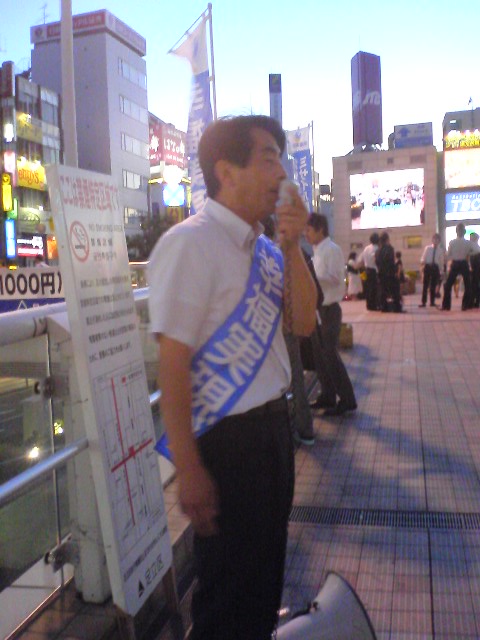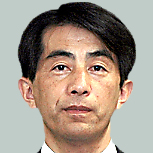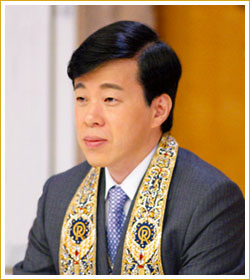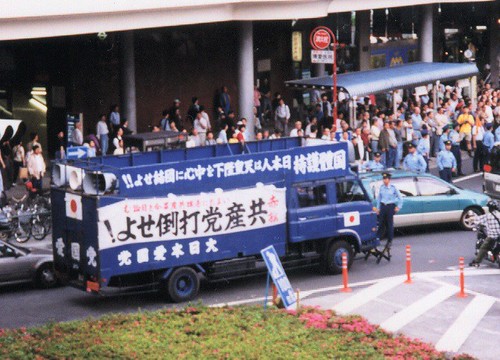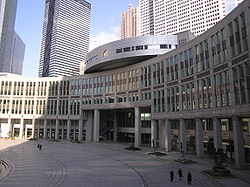Moving forward with my series on this upcoming election, today I would like to talk about the main issues at stake and outline the main parties in the race.
What are some of the issues in this election, and where do the main parties stand?
Bureaucratic control – As I mentioned in the last post, Japan’s bureaucracy has maintained control of the ship of state for most of the postwar period. The DPJ wants to fix that and create a system more like the British executive branch, while the LDP pledges to do some trimming around the edges.
Pensions – With the aging of Japan’s population, there is a widespread concern that the country’s pension system won’t be able to keep up. These concerns are no doubt bolstered when the government acts to limit benefits, as it has several times in recent history, or is caught losing records and misappropriating large chunks of the pension fund. As a result, the pensions issue turns up as the top priority for voters in most polls. A general consensus seems to have formed that the only way to fund the pension liabilities is to raise consumption taxes, but that remains a political third rail.
Depopulation – As mentioned above, the issue of population decline is a major source for concern, as the entire model for economic growth more or less hinges on a growing population. The prospect of relative economic decline has many Japanese putting off childbirth until later in life and settling in for a long-term period of mediocre lifestyles. To help assuage these concerns all parties have pledged one form or another of childcare support – The LDP pledges to make school affordable, while the DPJ has promised to give cash handouts to couples with children while levying tax penalties on single-income families with no children.No party is talking about expanding immigration as a way to stem depopulation, a move that would be controversial but has been widely argued for.
Economic turmoil/unemployment – The LDP has made the current economic downturn its top priority. Aso has repeated that it will take three years for Japan’s economy to fully recover (though it’s odd that he started saying that more than six months ago and he’s still saying “three years” in TV ads. Shouldn’t it be 2.5 years by now?) and will continue efforts to combat the short-term deficit.
Structural reform – Though the 2005 election was fought on the merits of privatizing the postal service, both parties appear set to revise the terms of privatization if they win this time around. Aso’s LDP pledges to “say goodbye to excessive market fundamentalism” while the DPJ has pledged to freeze the planned stock offerings of Japan Post’s banking and insurance arms. On other fronts, however, the DPJ seems to be more active in pursuing some structural reforms – namely, eliminating “special accounts” that are managed by various ministries, and taking on bureaucratic rule as a whole.
One area of policy where the DPJ and LDP differ very little is support of less central government control over Japan’s local administration (which is incidentally a long-term goal of the Ministry of Internal Affairs and Communication).
Both the LDP and DPJ have also proposed reforming the legislative branch of government. The LDP wants to reduce the size of both houses by 30%, while the DPJ has only proposed eliminating 80 of the 180 lower house proportional representation seats.
Foreign policy – Though it might not decide the election, the parties have real differences when it comes to foreign policy. The LDP is seen as willing to maintain the status quo of the US-Japan alliance, while the DPJ has made it clear they would seek some more fundamental renegotiation. Meanwhile, the DPJ is viewed as more willing to build close relations with China, as evidenced by DPJ president Yukio Hatoyama’s pledge not to visit Yasukuni Shrine as prime minister. The prevailing view of US Japan-watchers seems to be that if the DPJ takes power, these differences would mean real but manageable change, as outlined in this WSJ op-ed by Dan Blumenthal and Gary Schmitt.
What are the main parties and what are their platforms?
Liberal Democratic Party – This is the party that’s been in power for almost all of Japan’s post-war history. There’s some truth to the cliche that the LDP is “neither liberal nor democratic… nor a party” – the members tend to be more right-wing (closer to the European definition of “liberal”) though the internal factions have widely disparate policy objectives. Their campaign centers on positioning themselves as the more responsible party versus a spendthrift DPJ that can’t be trusted with power.
(You can take a look at an English-language policy brochure here (PDF))
Democratic Party of Japan – The current main opposition party was formed in 1998 and took its current form in 2003 from an merger of several smaller parties that had either formed or evolved from the messy political reorganization of the 1990s. The LDP was removed from power in 1993 only to take back the premiership in various convoluted coalition governments until things stabilized in 1998, when the New Komeito and the LDP solidified an alliance that continues to this day. The DPJ, therefore, is a wide mix of former socialists, moderates, and conservatives united principally in their desire to gain power (this is very similar to the LDP’s uniting factor).
People’s New Party (Kokumin Shinto in Japanese) – A breakoff of the LDP, Kokumin Shinto is the party I like to call the anti-postal privatization party. This party was formed in 2005 when Koizumi ousted dozens of his own party for voting against his bill to privatize Japan Post, an effort aimed at helping restore Japan’s financial soundness while cutting off the political base of some of his political rivals. These included some long-time political heavyweights such as Tamisuke Watanuki of Toyama and Shizuka Kamei of Hiroshima, who now lead Kokumin Shinto. Their entire platform boils down to opposition to postal privatization, as the postal interests have long been the members’ source of support and funding. They are allied with the DPJ on the condition that the DPJ support the bill to freeze the impending IPOs of the Japan Post Bank and Japan Post Insurance.
While Kokumin Shinto is somewhat single-minded, they have at times proven an adept opposition party, thanks to Shizuka Kamei, who is a foremost Soka Gakkai hater and opposition researcher.
New Party Nippon – This is another party formed in the wake of the LDP’s “postal rebellion” in 2005. It’s led by Yasuo Tanaka an author-turned-politician who led the fight against wasteful spending during his term as Nagano governor. This party remains tiny and in this election they are only fielding a few candidates.
Your Party – This is yet another party formed due a split in the LDP split, only this time the defectors are pro-structural reform elements. This party is led by Yoshimi Watanabe, a Tochigi Prefecture politician and former administrative reform minister who left the LDP after the party refused to implement his policy initiatives. His small party is also not expected to make much of an impact in this election, though if the results are close all small parties could become critical to forming a government.
New Komeito – This is the populist/pacifist party that serves as the political arm of lay Buddhist movement Soka Gakkai. With the third largest number of seats in the lower house, they are the LDP’s coalition partner and have pledged to stick with the LDP win or lose (yeah, right). They have a fairly stable voter base of Soka Gakkai believers, and so are expected to keep their current standing. They are campaigning on promises of administrative reform and enhanced social spending.
Japan Communist Party – The communist party in Japan has essentially renounced revolution as a means to achieve socialism and instead campaigns on labor and other populist issues. This election, as in 2005, they are emphasizing their role as a check on the conservative tendencies of the other parties. For instance, they devote the back page of their manifesto to criticizing some of the DPJ’s policies, though they are expected to enter into a coalition with them should the DPJ win. The DPJ’s success is likely to come at the expense of some of the JCP’s seats, especially in the proportional representation voting. Though the revival of 1920s communist propaganda The Crab Canning Ship has renewed interest in the JCP, it’s unclear whether that will help the party in this election. In last month’s Tokyo assembly election, the JCP actually lost seats. In my district the JCP is fielding a candidate against the LDP and DPJ.
Social Democratic Party – This center-left party is what remains of the Japan Socialist Party, the longtime permanent opposition under the 1955 system of semi-permanent LDP control. Since the 1990s their numbers have dwindled and they are struggling to remain relevant. They are also considered likely to coalition with the DPJ if they take the reins of government.
Happiness Realization Party – The sudden decision of new religion Happy Science, a personality cult of guru Ryuho Okawa, to form the Happiness Realization Party and run in the general election has raised eyebrows in Japan but not garnered much local press coverage. As I noted in my posts on the Tokyo assembly election, their campaign pledges make promises that don’t even seem physically possible – they want to eliminate most taxes, invade North Korea, and build a massive bullet train system all over the world. What does this have to do with reality? Not a whole lot, but the party seems to be betting that people are stupid enough to vote for “no consumption taxes.”
There are a couple other parties running, including Muneo Suzuki’s Shinto Daichi, a Hokkaido-specific party designed primarily to keep Suzuki in office. But they are too minor for me to bother with at this point.
***
In my next post, I will discuss the three likely post-election scenarios: Will the LDP stay on top, will the DPJ score a landslide and take over, or will the DPJ gains not be enough to form a government with the current opposition parties?


